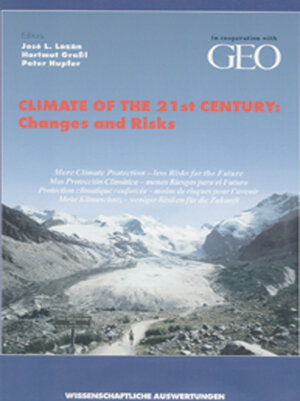
×
![Buchcover ISBN 9783980966894]()
Climate of the 21st Century: Changes and Risks
Scientists inform directly
von Jose L. Lozán, Hartmut Grassl und Peter HupferThe climate of the 21st century will be substantially influenced by humankind.
In this book, the reader will find information about future trends in air temperature,
precipitation, sea level, mountain glaciers, large ice sheets, sea ice cover,
permafrost, desertification and related variables that will influence plants and
animals, agriculture, forestry, the availablility of water, public health, and the urban
climate. In addition, an overview is provided of the history of climate and of
factors that cause it to change. Since the beginning of the industrial age, man has
increasingly influenced the climate of the Earth, especially through the growing
use of fossil fuels and the continued destruction of forests. The atmospheric content
of carbon dioxide has already risen by 30% and threatens to double by the
year 2035, if effective measures to reduce emissions are not taken. Further increasing
the amount of atmospheric carbon dioxide could cause temperatures to
rise even more rapidly to values, that have never existed in man‘s history. Some
of the man-made changes predicted for the 21st century during the 1980s, such
as warming, a rising sea level, and extended areas for some infectious diseases,
can already be detected now at the beginning of the century. 1990, 1995, 1998,
and 2000 were the warmest years of the 20th century. Displacement of climatic
zones will lead to social conflicts in the affected regions and result in migrations,
such as the one that occurred some years ago in the Sahel. The consequences for
the world economy, including water and food supplies for the world’s population
cannot yet be adequately assessed. The people alive now will not be so greatly
affected, but following generations will have to bear the main consequences.
This compilation of findings by climate researchers and the results of climate
impact investigations, by over 100 experts, gives the reader a comprehensive
description and assessment of the climate problem.
In this book, the reader will find information about future trends in air temperature,
precipitation, sea level, mountain glaciers, large ice sheets, sea ice cover,
permafrost, desertification and related variables that will influence plants and
animals, agriculture, forestry, the availablility of water, public health, and the urban
climate. In addition, an overview is provided of the history of climate and of
factors that cause it to change. Since the beginning of the industrial age, man has
increasingly influenced the climate of the Earth, especially through the growing
use of fossil fuels and the continued destruction of forests. The atmospheric content
of carbon dioxide has already risen by 30% and threatens to double by the
year 2035, if effective measures to reduce emissions are not taken. Further increasing
the amount of atmospheric carbon dioxide could cause temperatures to
rise even more rapidly to values, that have never existed in man‘s history. Some
of the man-made changes predicted for the 21st century during the 1980s, such
as warming, a rising sea level, and extended areas for some infectious diseases,
can already be detected now at the beginning of the century. 1990, 1995, 1998,
and 2000 were the warmest years of the 20th century. Displacement of climatic
zones will lead to social conflicts in the affected regions and result in migrations,
such as the one that occurred some years ago in the Sahel. The consequences for
the world economy, including water and food supplies for the world’s population
cannot yet be adequately assessed. The people alive now will not be so greatly
affected, but following generations will have to bear the main consequences.
This compilation of findings by climate researchers and the results of climate
impact investigations, by over 100 experts, gives the reader a comprehensive
description and assessment of the climate problem.


